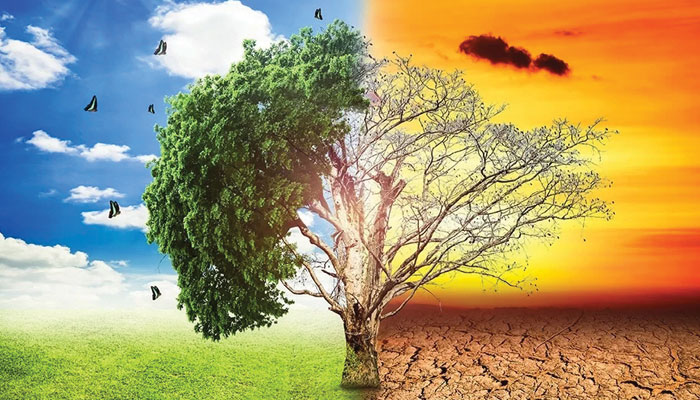Faith is small
Scientists are uncovering current secrets and unveiling new discoveries as well as predicting future changes. Experts believe that due to increased global warming and increased human warming, the time will come soon after several centuries. According to a report, the average global temperature in 2022 has been 1.2 degrees higher than the pre-industrial temperature, and that is why we are fast approaching the 1.5 degree temperature target, which scientists have called for. was set for the end of the 21st century, to reduce the effects of global warming.
According to Gavin Schmidt, NASA’s director of space studies, global warming is not slowing down even though everything seems to be destroying the system. Experts say that even if the emission of toxic gases reaches zero in the coming times, the process of climate change caused by humans will continue for centuries and we all know that the emission of toxic gases will never stop. can’t Scientists are trying to reduce these difficulties to some extent by slowing down these conditions.
It may be difficult for all of us to accept all these situations, but if such situations continue, what will happen to the world in the next 100 years. We can estimate it very well. According to experts, it is impossible to limit the temperature increase to 1.5 degrees Celsius as a long-term goal, and given the current conditions, it is certain that by 2030 we will surpass this target. However, experts are optimistic that it can be stopped after reaching 2 degrees Celsius above pre-industrial levels, the target set by the United Nations. That will not happen, and if we stop somewhere between these two goals now, then by the end of this century it is certain that the world’s average temperature will rise by 3 degrees Celsius compared to the present. But the increase in temperature alone does not present the true scenario of climate change, but the normal temperature in an area will rise and fall very quickly and lead to the destruction of the environment there. For example, in the Arctic winter a few years ago. Temperatures in the Circle exceeded zero for one day, although it was freezing in Florida at the time, but the Arctic warmed very much, which was unusual and likely to happen in the future.
Experts say that as a result of such events, the loss of sea ice will become the norm, and by 2050, Greenland’s summer ice removal will become common, when 97 percent of Greenland’s ice will be gone. The layer melted in the summer, which normally happens once a century, but by the end of this century we will be seeing this type of event once every 6 years. But the good news is that the Antarctic ice will remain fairly stable and will not have much impact on sea level rise. Another major problem as a result of climate change is sea level rise, and even in the best-case scenario, an average of 2 to 3 feet of sea level rise by 2100 is likely, which would be catastrophic.
For example, if the sea level rises by three feet, it could result in 4 million people being displaced. The oceans will not only face the problem of less ice at the poles, but the acidity of their waters will also increase. Oceans around the world absorb a third of the carbon dioxide at their surface and are therefore becoming warmer and more acidic.
Experts say that if the increase in climate change continues in the same way, then all the coral reefs in the oceans will disappear. It seems, but the oceans are not only boiling due to the increasing temperature of the oceans, even if we reduce the emission of toxic gases, by 2050, the intensity of heat in humid areas will increase by 50 percent during the day and Days in the north will be 10 to 20 percent warmer. This is in the form of a reduction in the emission of toxic gases, if the current situation continues, the global summer temperature will rise unbearably.
According to experts, even a slight rise in temperature will prove disastrous for water sources. According to a study, soon the world will face the days of severe drought and if these conditions remain the same, the rate of severe drought worldwide will increase to 40 percent, which is twice as much as today. Also, weather issues will be different, El Niño waves in 2015-2016 suggest that we will face more dramatic natural disasters in the future, more destructive storms, more forest fires. While heat waves will become normal by 2070.
Humanity is standing on a precipice right now, we can ignore the warning signs and pollution to some extent, but know that in the next few decades we will be forced to live on a very different planet, the current one. A completely different land from a distant climate will be our destiny. Or we have to turn to creative solutions. Experts say that in any case by 2100 we will be on an earth that will be much warmer than today and this difference will determine the scale of saving or ending millions of lives. To stop it, we have to make important decisions now.
setTimeout(function(){
!function(f,b,e,v,n,t,s)
{if(f.fbq)return;n=f.fbq=function(){n.callMethod?
n.callMethod.apply(n,arguments):n.queue.push(arguments)};
if(!f._fbq)f._fbq=n;n.push=n;n.loaded=!0;n.version=’2.0′;
n.queue=[];t=b.createElement(e);t.async=!0;
t.src=v;s=b.getElementsByTagName(e)[0];
s.parentNode.insertBefore(t,s)}(window,document,’script’,
‘https://connect.facebook.net/en_US/fbevents.js’);
fbq(‘init’, ‘836181349842357’);
fbq(‘track’, ‘PageView’);
}, 6000);
/*setTimeout(function(){
(function (d, s, id) {
var js, fjs = d.getElementsByTagName(s)[0];
if (d.getElementById(id)) return;
js = d.createElement(s);
js.id = id;
js.src = “//connect.facebook.net/en_US/sdk.js#xfbml=1&version=v2.11&appId=580305968816694”;
fjs.parentNode.insertBefore(js, fjs);
}(document, ‘script’, ‘facebook-jssdk’));
}, 4000);*/


